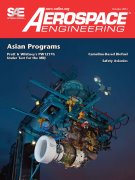Article
Air Force tests fully autonomous UAS control system
2019-03-12
The United States Air Force’s 412th Test Wing’s Emerging Technologies (ET) Combined Test Force (CTF) completed the first flight test of Johns Hopkins University’s Testing of Autonomy in Complex Environments (TACE) system. As “middleware,” TACE serves as an “autonomy watchdog,” monitoring commands sent to an aircraft’s autopilot software from its autonomous artificial intelligence (AI) computer and transmitting autopilot information such as position, speed, and orientation back to the AI.




